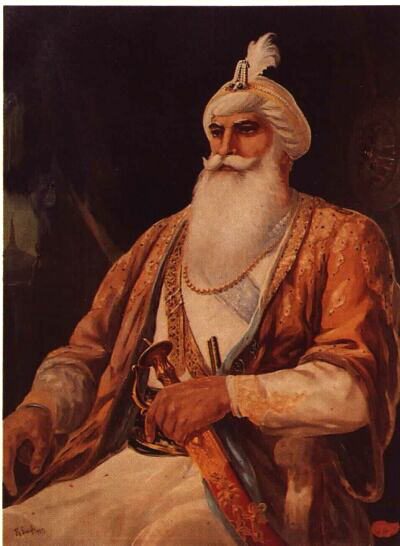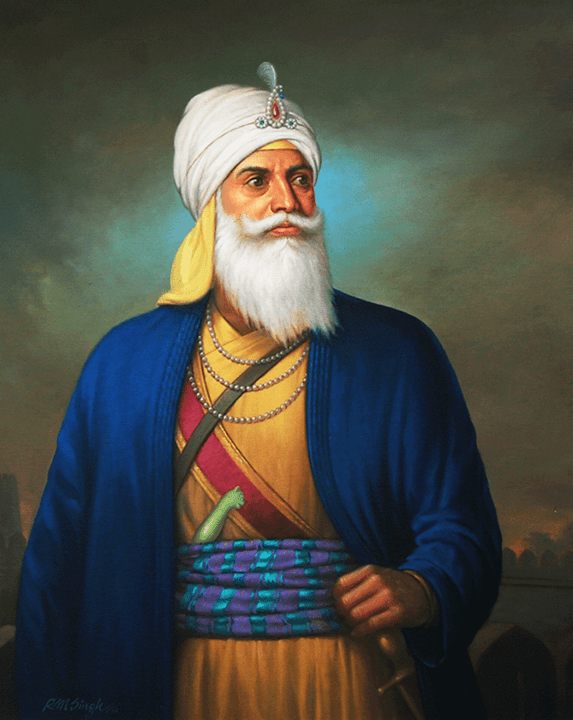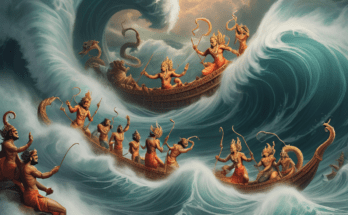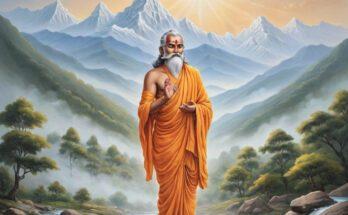Sardar Jassa Singh Ahluwalia- Nightmare of
Ahmed Shah Abdali
The Brave heart who became Nightmare of Afghani Looters and slave traders…
Baba Jassa Singh Ahluwalia Ji was a champion warrior. Under his leadership, Dal Khalsa inflicted humiliating defeats on Nadir Shah, Mir Mannu, Adena Beg, Zakria Khan, Salabat Khan and Jahan Khan.
“Wahe Guruji da khalsa, Wahe Guruji di fateh!”,
The war began against an enemy considerably larger in number and infamous for brutality with the above war-cry. Sikh army was always fought to taste victory, this war cry from their leaders infused huge confidence in them. They fought with all their might, and they fought to win.
To put an end the growing Maratha power, Ahmad Shah Abdali – the Afghan king along with his allies – the Rohilla Afghans of the Doab, and Shuja-ud-Daula of Awadh – had descended on the Maratha army with all his might in the 3rd battle of Panipat on 14 january 1761. The Marathas fought bravely but were outmatched to the combined mighty armies of Abdali and its allies.
Abdali had kidnapped 2,200 Hindu women as part of his war spoils and was carrying them to Afghanistan, to be sold there for slavery. The relatives of these women had requested the Sikh forces in Amritsar for rescuing them and ensuring their safety.
Jassa Singh Ahluwalia, the Sikh leader, on learning about this incident, immediately left with a team of his volunteers and caught up with the Afghan forces at River Sutlej in Goindwal. It needed great courage to fight the mighty Afghan army who were still high on confidence from their recent victory in the Panipat.
Jassa Singh Ahluwalia and his men pounced on the enemy with great vigor and took them by surprise. The once outnumbered looking Sikh army was now making the Afghans run for their lives. All the Hindu women were rescued and escorted to their families. Jassa Singh, was now a household name in north India. This incident had now earned him the title of “Bandi Chhor” ( The Liberator. )
Jassa Singh Ahluwalia was born on 3rd May 1718 in the village of Ahlu, Lahore. Ahlu or Ahluwal village near Lahore, was established by his ancestor, Sadda singh, who was a devotee of Sixth Guru, Hargobind. Hence the name Ahluwalia stuck to him. His forefathers were kalals (wine merchants). Hence he is also called Jassa singh Kalal.

Punjab (then in undivided India) was in constant struggle against the jihadi armies of Muslims rules of Delhi and invaders from Afghanistan. The fight for Punjab’s freedom then had taken a great hit. Banda Bahadur and his followers had been brutally executed by Mughals in June,1716.
His father, Badar Singh, died when he was only five. He, along with his mother, went to Delhi to live under the care of Mata Sundri, the widow of Guru Gobind Singh. There they lived for next 7 years. Mata Sundri brought him up affectionately. He studied Persian, Arabic, Sikh scriptures and mathematics at Delhi. On his departure from Delhi, Mata Sundri blessed him and predicted that he would become a worthy leader of the Sikhs.
These initial years of his life that he spent here that made him so dedicated for the Sikh cause and rise to fight for his people. Emperor Farukh Saiyyar had declared a bounty of Rs.50 per Sikh head. The threat of being attacked was now greater than ever but these sons of Bharat Mata were real lions. To get a Lion’s head you need to kill the Lion first. These hostile conditions only emboldened Jassa will to raise and crush the falling Mughal empire crush the tyranny of other Muslim rulers.
Later, Mata Sundri asked Nawab Kapur singh to take charge of the promising youth. Both he and his mother used to perform Hari-Kirtan before Nawab Kapur singh who much pleased at his supreme devotion to the faith and sense of duty and humility, appointed him as a storekeeper with his forces. As was natural, he participated in many combat as well where he displayed such qualities of leadership that Nawab Kapur singh appointed him his successor on the eve of his death in 1753. Elated at his successful helmsmanship, the Khalsa honored Jassa singh with the title of Sultan-ul-Qaum (king of the whole people), when they captured Lahore in 1761.
By 1762, Sikhs had already became the biggest cause or worry for Abdali.
On Feb 5 1762 , Sikhs were especially the target of Ahmad Shah Abdali Sixth invasion into India. News had reached him in Afghanistan of the defeat of his general, Nur-Ud-Din Bamezai, at the hands of Sikhs who were fast spreading themselves out over the Punjab and had declared their leader, Jassa Singh Ahluwalia, king of Lahore. To rid his Indian dominion of them once for all, he set out from Kandahar. Marching with alacrity, he overtook the Sikhs as they were withdrawing into the Malwa after crossing the Sutlej.
Surprised by Ahmad Shah, the Sikhs threw a cordon round those who needed protection, and prepared for the battle. In this formationand continuing their march, they fought invaders and their Indian allies (Nawab of Malerkotla, Sarhind, etc. ) desperetely. Charat Singh, Hari Singh Bhangi and Jassa Singh Ahluwalia led their forces with skill and courage. Jassa Singh ahluwalia sustained sixty four wounds on his body and Charat Singh rode to exhaustion five of his horses one after another.
Near the village of Kup, in the vicinity of Malerkotla, about 20,000 Sikhs lay on that ghastly field at the end of a single day’s action (February 5, 1762). This battle in Sikh history is known as Wadda Ghalughara.
Jassa singh fought valiantly and received 64 cuts, but he survived. Even such a disaster as had overtaken them at Kup caused no despondency among the Sikhs. When the survirors of of the Great carnage assembled inthe evening for their prayers. A Sikh got up and said
“No harm done, Khalsa ji! The Panth has emerged purer from the trial; the alloy has been eliminated.”
Abdali also went ahead and blew up Harmandir Sahib (Golden Temple) at Amritsar with gunpowder. Nothing remained of Harmandir Sahib, but Abdali was not satisfied with this. The barbarian filled the holy tank with remains of dead cows.
Jassa Singh Ahluwalia was determined to seek vengeance and to rebuild the temple at the first opportunity.
Within four months of Ghalughara, Sikhs under Jassa Singh Ahluwalia inflicted and a severe defeat on the Abdali’s governor of Sarhind.
Within 4 months of Ghalughara, Jassa Singh Ahluwalia conquered Sarhind, the richest province of the empire. Sikhs punished Abdali’s Muslim commander Jain Khan. Jain Khan was away from Sirhind recovering revenues from different Nawabs, when Sikhs moved in to face him before he could get back into the fort. When encircled by the Sikhs, he tried to slip away leaving his men entangled with the Sikhs. But Jassa Singh had organized the attack very well. When Khan was leaving the battlefield to escape, the watchful Sikhs shot him dead.
He donated his entire share of the spoils from this war, which amounted to 9 lakh rupees to rebuild the Harmandir Sahib, the one which we see today. This great act of generosity, referred to as ‘Guru ki chaddar’ earned him great popularity and following among his followers. The regions around Sirhind were divided among the Sikh Misldars. Gurdwara Fatehgarh Sahib was built in Sirhind where the two younger sons of Guru Gobind Singh were murdered.
Abdali had thought that having demolished their fort and desecrated their holy Sarovar, he had crushed Sikhs and they were rendered unable to face the Afghans. However, within 4 months, the Sikhs, guided by Ahluwalia, were strong enough to make Afghans their prisoners, and made them clean up the Amrit Sarovar. Sikhs were celebrating Diwali in Harimandir which the Shah had demolished, and were fighting pitched battle forcing Abdali to withdraw from Amritsar under cover of darkness (October 17,1762).
Sikhs took over Lahore again in 1765.
Jassa Singh Ahluwalia’s other victories include the defeat of Shah Nawaz of Multan, conquest of Khwaspur and Fatehbad in 1753, defeating Aziz Beg and Bakhinda Khan in 1754, Buland khan and Saadat Khan in 1757, Ubaidullah Khan, Hira Mal, Gulsher Khan. Jahan Khan – the outstanding generals of Abdali. In the decisive battle with Ubaid Khan, he proved to be better and captured Lahore in 1761.
All these defeats made Abdali go defensive, Abdali’s authority was now confined to his own camp. Lahore was now occupied by Dal Khalsa and Punjab had tasted freedom after 700 long years. But Jassa didn’t stop here – Sikh conquests continued, leading to the victory of Delhi in 1783.

The fear of his Indian empire falling to the Sikhs continued to obsess the Ahmad Shah Abdali’s mind. In 1767, when Abdali came again(This was his 8th attack) , he sent messages to the Sikhs for their cooperation. He even offered them the governorship of Punjab but none of them accepted it.
The Sikhs had recourse to their old game of hide and seek. They vacated Lahore, but faced squarely the Afghan general, Jahan Khan at Amritsar, forcing him to retreat, with six thousand Abdali’s soldiers killed.
Jassa Singh Ahluwalia with an army of about twenty thousand Sikhs roamed in the neighbourhood of the Afghan camp plundering it to his heart’s content. Never before Ahmad Shah Abdali had felt so helpless, his dream of capturing the whole of India was dying before his own eyes.
In the words of a contemporary writer:
“The Shah’s influence is confined merely to those tracts which are covered by his army. The Zamindars appear in general so well affected towards the Sikhs that itis usual with the latter to repair by night to the villages where they find every refreshment. By the day they retire from them and again fall to harassing the Shah’s troops. “
Sikhs continued to harass him with repeated guerilla attacks. They took away his caravan of 300 camels loaded with fruits from Kabul. As soon as he crossed the river Satlej on his way to Delhi, the Sikhs were again in control of the areas between Satlej and Ravi.
Jassa Singh had so well prepared his men to fight that Abdali did not dare return to Kabul through Amritsar and Lahore. He took a long circuitous route through Multan. After his departure to Kabul, Sikhs crossed the Satlej and brought Sirhind and other areas right up to Delhi, under their control.
The Emperor of Delhi, Shah Alam II, was staying away in Allahabad; he did not come to Delhi for fear of the Sikhs. Alam ordered his commander Zabita Khan to fight the Sikhs. Zabita, knowing that he could not face the Sikhs, made a truce with them instead. Later, Alam dismissed him from service. Zabita Khan came to the Sikhs’ camp and he was welcomed by them. He became a Sikh, and was given a new name, Dharam Singh.
But Jassa didn’t stop here – Sikh conquests continued, leading to the victory of Delhi in 1783.
However, he sat on the throne of Hindustan for just one day and left shortly but not before entrusting the task of building 8 main gurudwaras of Delhi to his trusted lieutenant, Baghel Singh.
Such was the courage and fighting quality of the Sikh troops that even the Afghans couldn’t help but be in awe. Nur Mohamand, brought along with Abdali to write an account of his 1764-65 campaign initially referred to the Sikhs as dogs but later with great reluctance had to change his mind by the end of the campaign. In his Jungnama he wrote
“Sikhs are great experts in the use of the sword and the art of war. Like lions, they jump on the enemy, like foxes they run away and get out of our reach. Their bodies are rock hard and in physical strength, one Sikh is the equivalent of more than 50 men. If they flee in a battle, don’t assume that they have been defeated. That is just part of their tactics because they suddenly turn back and murder all those who pursue them. Come and see these lions in the battlefield to learn the art of war from them.
They do not kill a woman, a child or a coward running away from the fight. They do not rob any person nor do they take away the ornaments of a woman, be she a queen or a slave girl. They commit no adultery, rather they respect the women of even their enemies. They always shun thieves and adulterers and in generosity, they surpass Hatim.”
Known for his courage and fearlessness ( he was reputed to have 32 war-wounds on his body), he was the one who instilled faith in the Sikhs. He united the misl leaders (leaders of different smaller warrior groups) and made them fight for a common, greater cause. An adept warrior who always led his troops to victories, Jassa Singh Ahluwalia was hugely respected for this tall moral stand.
Most people would have revenge as the only sentiment at their oppressors but Jassa was different. He ensured prisoners of war were treated with dignity and there were no cases of cold blooded murders. In a war, if the enemy soldier laid down his weapons, he was allowed to walk free, unharmed. He never forced religious conversions on his enemies and believed that there are several path that lead to the God and each one should be free to decide and follow his own.
Under his leadership, Sikh troops sailed many campaigns. Jassa Singh Ahluwalia fought for 50 years of his life with the Mughals and won most of the victory.
In 1777, Jassa Singh Ahluwalia conquered Kapurthala and made him the capital of Khalsa.
On 11 March 1783, Dal Khalsa, led by great fighters Jassa Singh Ahluwalia, Baba Baghel Singh, Jassa Singh Ramgarhia and Tara Singh Gheba, won the Khalsa flag at the Red Fort by conquering Delhi and the one who sat on Delhi’s throne was Jassa Singh Ahluwalia, who became the Sultan-ul-Nom. After the martyrdom of Baba Banda Singh Bahadur, Jassa Singh Ahluwalia has emerged as the greatest hero of the time
Jathedar Jassa Singh Ahluwalia, honored as Sultanul Kaum (King of the Nation) was a devout Sikh. He was not greedy and did not attempt to add more areas to his Misl. Instead, whenever any wealth or villages came into the hands of the Sikhs, he distributed them among the Jathedars of all the Misls. Having lead the Sikhs through very trying times, Jassa Singh passed his last years in Amritsar. With the resources available to him, he repaired all the buildings, improved the management of the Gurdwaras, and provided better civic facilities to the residents of Amritsar.
Jassa Singh Ahluwalia passed away in the year 1783 and as a mark of his services to the community he was cremated within the precincts of Harmandir Sahib, where his samadh exists today. There is a city block, Katra Ahluwalia, in Amritsar named after him. This block was assigned to his Misl in honor of his having stayed there and protected the holy city. At this time the combined armies of Dal Khalsa(Sikh Army) totaled approximately 200,000 fighter with 60,000-70,000 horses. Sikh rule extended from Lahore, Multan to Jammu, Kashmir, the Kangra hills to Delhi. Their influence also extended further to the Ganga Doab, Rajashthan, and Agra.
Following lines are attributed to Guru Gobind ji and Sardar Jassa Singh Ahluwalia truly lived to these.
Chidya naal main baaz ladava,
Tabhi Guru Gobind Singh naam kahawa
(I will make the sparrows capable of fighting the hawks, for it is only then that i will be able to uphold my name.
In the memory of that great warrior, the Government of India had issued a postage stamp in 1985.

List of related posts of Hindu warriors’ bravery:
- Maharani Durgavati-Saffron Swords by Manoshi Sinha
- Brave Kuyili sacrificed herself life to win over Britishers 1780
- Queen of Ullal- Braveheart Abbakka Chowta
- Queen Hadi Rani who sacrificed herself for Rajput Honour
- Kiran Devi with her dagger on Akbar’s throat
- Story of Brave Lady Onake Obavva
- A Tale of Bravery and Chivalry : Rajputs
- Maharaja Chhatrasal Bundela- Victor of 52 glorious wars
- Overview of Brave resistance of Hindus against Islamic jihad in Kerala
- Braveheart Prataprao Gurjar – Battle of Salher, 24 February 1672
- Jaimal Rathore of Badnor and Patta of Kelwa
- Maharaja Yashwantrao Holkar who defeated British every time
- King Sambhaji Raje & Knight Williams Wallace- Two warriors, similar life
- Tanaji Malusare -The Lion of the Famous Singhgadh Fort War
- Freedom fighters Periya Marudhu and Chinna Marudhu
- The 27 Years Maratha War(1681 to 1707A.D.) which saved Hinduism
- Battle of Kamrupa-King Prithu annihilated and Bakhtiyar Khilji finally
- King Suheldev routed out 10 lac strong army of Invader Salar Masood
- Sardar Jasaa Singh Ahluwalia- Abdali’s Nightmare
Dibhu.com is committed for quality content on Hinduism and Divya Bhumi Bharat. If you like our efforts please continue visiting and supporting us more often.😀
Tip us if you find our content helpful,
Companies, individuals, and direct publishers can place their ads here at reasonable rates for months, quarters, or years.contact-bizpalventures@gmail.com






And we were taught as if Abdali never lost and went scot-free. Thanks for sharing this information.Keep up good work!
Thank You Sir!
Guru ka lal jassa kalal ? ??
Hmari kalal community ki jaan ho AP???
Abdali was a coward..beaten by many people.